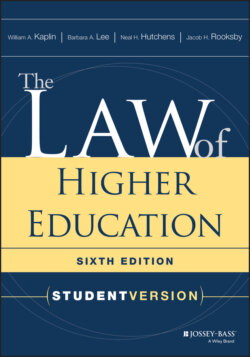Читать книгу The Law of Higher Education - William A. Kaplin - Страница 27
F. The U.S. Legal System As It Relates to Higher Education Law
ОглавлениеThe law applicable to higher education emerges from both the context of federalism (the division of powers between federal and state governments) and the context of separation of powers (the allocation of powers among the legislative, executive, and judicial branches of government). Legal issues concerning higher education may thus arise not only in the courts (state courts and federal courts) but also in Congress, state legislatures, and local government legislative bodies, and in a wide variety of federal, state, and local administrative agencies—all of which are important participants in the “external” governance of higher education (see Section B above). Similarly, legal disputes and problems may be resolved not only in judicial opinions but also in statutes and ordinances, and in administrative regulations and rulings. It is important, therefore, for students studying higher education law to have a basic understanding—in relation to higher education's concerns—of the U.S. legal system, the system of courts that is a constituent part of the legal system, the use of court cases as legal precedents, the roles of lawyers within the legal system, and the legal materials and research tools by which one accesses the law developed through the legal system.
Various sections of Chapters 1 and 2 of the Student Version include basic introductory background on these matters. Some of the legal concepts and descriptive material in these chapters may already be generally familiar to law students and lawyers, who may use this material for review and to sensitize themselves to the particular concerns of higher education. Students and educators without legal training or background, on the other hand, should find the material in Sections 1.3.3, 1.5.1, and 1.6.1 to be especially helpful. Sections 1.3.3, 1.5.1, and 1.6.1 provide basic information on the U.S. legal system; Sections 1.4.4, 2.1.4, and 2.2.1 provide basic information on the U.S. court system; Sections 1.7 and 2.1.7 provide basic information on the roles of attorneys; Sections 1.4.2, 1.4.4, and 1.4.5 provide basic information on “case law” and other legal materials and research tools. In addition, Sections 11.1, 11.2.1, and 11.3.1 of this book, taken together, describe the constitutional structure of federalism as it applies to higher education. In addition, Appendix A of this book, “The Constitution of the United States: Provisions of Particular Interest to Postsecondary Education,” provides an overview of the U.S. Constitution, which is the foundation and framework for the entire U.S. legal system; Appendix B, “The Judicial System of the United States,” provides an organizational overview of the federal and state courts; and Appendix C, “Reading and Analyzing Judicial Opinions,” provides an introduction to the study of case law.
For further information on these matters geared specifically to education students and educators, but also of use to law students and lawyers, see Sarah Redfield, Thinking Like a Lawyer: An Educator's Guide to Legal Analysis and Research (Carolina Academic Press, 2002), a resource that focuses directly on education students' and educators' interactions with law and lawyers; and Steve Permuth, Ralph Mawdsley, and Susan Silver, Research Methods for Studying Legal Issues in Education, 2d edition (Education Law Association, 2015), which addresses qualitative and quantitative methods as well as policy-oriented methods for research in education law. For other helpful resources, see the following publications:
1 Regarding an introduction to the American legal system, including the system of federal and state courts, see Margaret Johns and Rex Perschbacher, The United States Legal System: An Introduction (4th ed., Carolina Academic Press, 2017); E. Allan Farnsworth, An Introduction to the Legal System of the United States (4th ed., Oxford University Press, 2010); Stephen Elias, Legal Research: How to Find and Understand the Law (18th ed., Nolo, 2018), Chapters 3 and 7; and Steven Burton, An Introduction to Law and Legal Reasoning (3rd ed., Aspen Publishers, 2007), Chapters 6–9.
2 Regarding the legal profession and the role of lawyers, see Johns and Perschbacher, above, Chapter 2.
3 Regarding the basics of legal research and analysis, see AALL Legal Information Service to the Public, How to Research a Legal Problem: A Guide for Non-Lawyers (American Association of Law Libraries, available at https://www.aallnet.org/wp-content/uploads/2018/01/HowToResearchLegalProblemFinal_2014.pdf; Burton, above, Introduction and Chapters 1–5; Elias, above; and Christopher Wren and Jill Wren, The Legal Research Manual (2d ed., Adams & Ambrose, 1999).
4 For definitions and explanations of legal terms, see D. Mellinkoff, Dictionary of American Legal Usage (West, 1992); Elias and Levinkind, above, Appendix C, and Wren and Wren, above, Appendices L and M.
